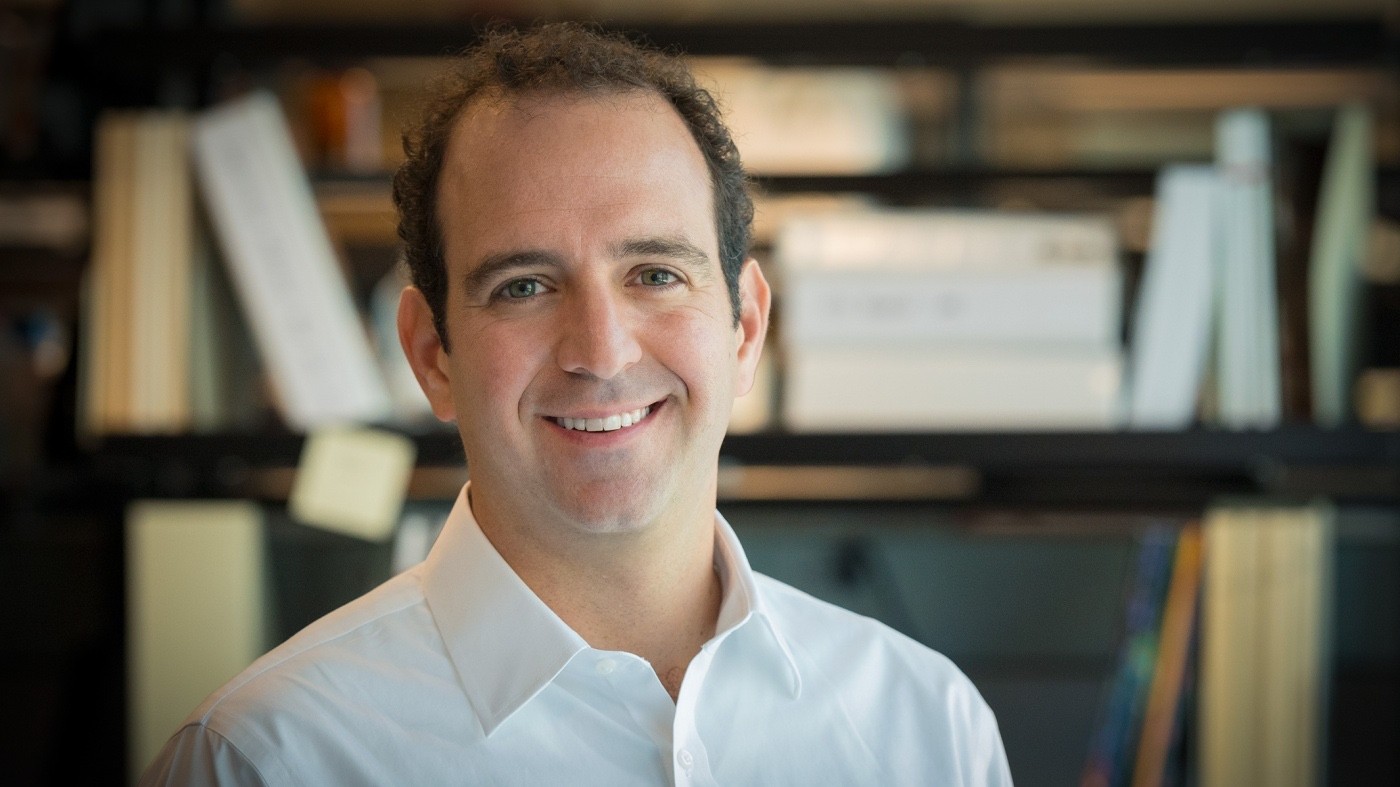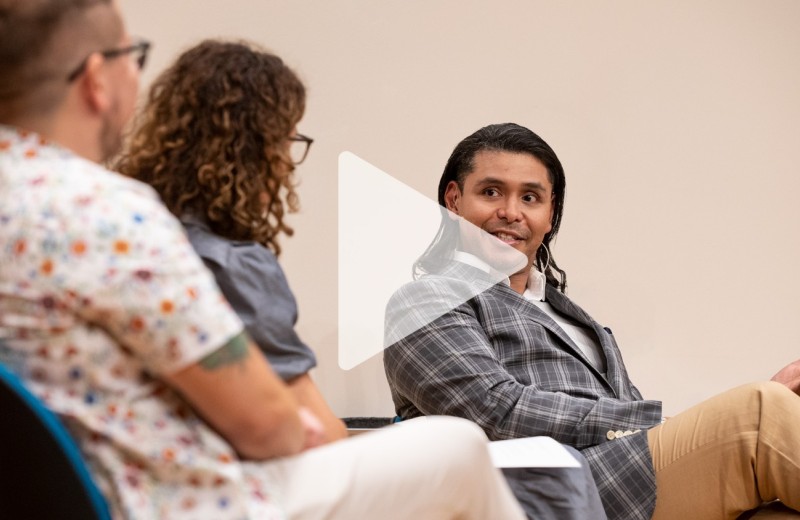
Leor Weinberger, PhD, is using innovative techniques to fight rapidly evolving, disease-causing viruses and overcome the challenges of drug resistance. [Photo: Chris Goodfellow, Gladstone Institutes]
Researchers at the Gladstone Institutes are working to turn a virus against itself, exploiting its process of replication to fight infection. Their work may lead to better prevention and treatment of some of the world’s most devastating pandemics.
Disease-causing viruses have long dominated both public awareness and the efforts of dedicated scientists. In the mid-20th century, a polio outbreak frightened people worldwide and led to the eventual discovery of a vaccine. In the 1980s, the AIDS crisis led to the identification of HIV, a pivotal step in understanding the disease and developing antiretroviral therapies to suppress it. More recently, the Ebola outbreak in West Africa affected a reported 28,000 persons, with at least 11,000 deaths attributed to the disease. And this year our attention is turned to Zika, a virus that first appeared in tropical areas and is now making its way north. A disease with flu-like symptoms, Zika has been shown to pose a dire threat to pregnant women, who, if infected, may give birth to babies with microcephaly and other brain disorders.
HIV, Ebola, and Zika are all rapidly evolving, disease-causing viruses that are difficult to treat, with barriers that include drug resistance and limited access to effective therapies, especially in high-risk populations. By exploiting the viruses’ genetic structure and harnessing the power of their quick evolution, Gladstone scientists in the laboratory of Leor Weinberger, PhD, are attempting to address these obstacles. They are focused on two novel antiviral strategies, therapeutic interfering particles (TIPs) and dominant negative mutations, that can help overcome the challenges of drug resistance and providing therapy to hard-to-reach populations.
TIPs: A Virus for a Virus
The primary challenges posed by infectious viral diseases arise from three core characteristics that are inherent to viruses: evolution—viruses mutate but drugs do not; persistence—viruses evolve mechanisms to remain in the host, but drugs are cleared; and transmission—viruses are communicable but drugs are not. The result of this disconnect is that deployment of effective therapies always lags.
These challenges are exemplified by the HIV/AIDS pandemic. Despite substantial progress made in treating the virus, an estimated two million people are newly infected with HIV each year, primarily in resource-limited areas such as sub-Saharan Africa. This is partly because HIV evolves resistance to drug therapy rapidly, which is why most patients need a “cocktail” of three antiviral drugs to effectively suppress viral replication. HIV also has lifelong persistence, which means most patients will need lifelong adherence to therapy. Additionally, HIV transmission patterns are highly heterogeneous, including some “super spreaders” who spread the virus to numerous people. Together, these challenges have thwarted the pursuit of highly suppressive antiretroviral drugs and effective pandemic control.
An approach using TIPs, a concept Weinberger pioneered in 2003, may help overcome all of these challenges by using the virus’s own tactics against itself. TIPs uses molecular parasites that insert themselves into the virus’s replication system, enabling the particles to co-evolve and be transmitted with the virus. Through this hijacking, TIPs also prevents the virus from reproducing and causing more harm.
“Like the oral polio vaccine and the viruses themselves, TIPs could be transmitted between individuals, which could help us reach people even in resource-poor settings,” said Weinberger. “Using epidemiological models, our lab has demonstrated that these engineered molecular parasites designed to piggyback on HIV—viruses of the virus—could circumvent the barriers inherent in treating this disease and dramatically lower the spread of infection.”
Dominant Negative Mutations: Taking Advantage of Viral Mutations
Viral resistance to drugs occurs in large part because the virus replication process is error-prone, and the resultant genetic mutations may promote drug resistance. Treatment with antiviral drugs can subsequently result in the inadvertent “selection” of mutated viruses that are resistant to the drug’s effects, making them difficult to treat. However, the reverse is also a true, and naturally occurring gene mutations can disrupt a virus’s ability to replicate. In fact, some mutations are so damaging that a mutant virus can even stop functional viruses from growing. Scientists in the Weinberger lab are now trying to exploit these dominant negative mutations to defeat the virus.
“When multiple genetic variants of the same virus replicate within a cell, they can potentially interfere with each other, reducing the virus’s overall ability to reproduce and spread,” said Elizabeth Tanner, PhD, a postdoctoral fellow in the Weinberger lab. “My work explores ways to exploit this type of genetic interference by taking advantage of the virus’s inherent genetic diversity.”
Deliberate genetic interference can help ensure that dysfunctional variants of the virus stop the spread of pathogenic variants. Tanner has used this approach in poliovirus, and she is now applying the method to the Zika virus. By adding dominant negative mutants to a spreading Zika infection, she hopes to stop virus growth in its tracks. Another benefit to this type of intervention is that the therapy should continue to work long after a traditional drug would fail.
“Given the success in polio, we hope this strategy will be applicable to other viruses,” Tanner said. “This approach could offset treatment with antiviral drugs and, in turn, lower the cost of care and reduce the potential side effects of antiviral therapy.”
Different Mechanisms, Same Promise
TIPs and dominant negative mutations use different mechanisms, but both rely on genetic interference to counter viral population heterogeneity, lower the viral burden, and help overcome the obstacles facing current antiviral therapies. Both have the potential to overcome major obstacles in controlling disease, including drug resistance and population-level barriers that prevent effective deployment of therapy, especially for hard-to-reach, often disenfranchised people across the world.
Support Discovery Science
Your gift to Gladstone will allow our researchers to pursue high-quality science, focus on disease, and train the next generation of scientific thought leaders.
How Understanding RNA Structure Can Help Researchers Design Better HIV Drugs
How Understanding RNA Structure Can Help Researchers Design Better HIV Drugs
New research sheds light on the biological effect of the many possible three-dimensional structures of a critical loop of RNA in HIV
Research (Publication) HIV/AIDS Virology Ott Lab40 Years of HIV Research: Celebrating the Career of Virologist Warner Greene
40 Years of HIV Research: Celebrating the Career of Virologist Warner Greene
Colleagues look back on Warner Greene's 40 year career
Gladstone Experts History HIV/AIDS Virology Greene LabIn Conversations with Adam Castillejo, the London Patient
In Conversations with Adam Castillejo, the London Patient
Watch this panel discussion that addresses the impact and hurdles associated with developing a cure for HIV
HIV/AIDS Ott Lab



